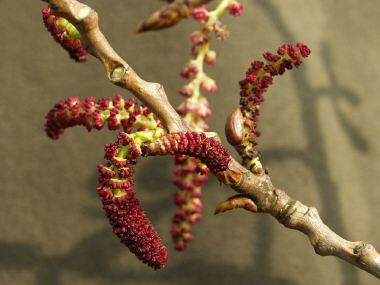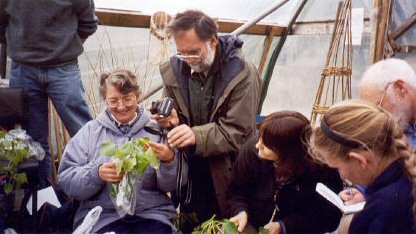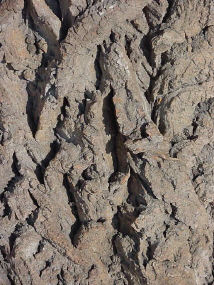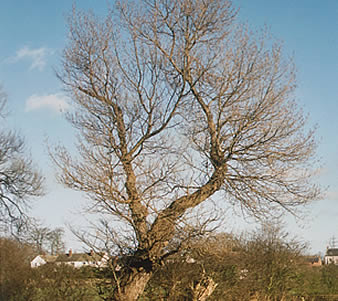NATIVE BLACK POPLAR
(POPULUS NIGRA SUBSP. BETULIFOLIA)
LOCAL BIODIVERSITY ACTION PLAN
Links
to associated HAPs
None
Current
Status
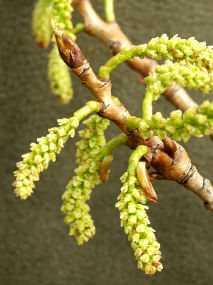 The
black poplar, which is considered to be native in Britain, is a segregate population
of the Atlantic race of Populus nigra subsp. betulifolia, and is thought to
be the most endangered native timber tree in Britain (White, 1993). In Cheshire
the black poplar survives at the north western limit of its range, however the
old, scattered trees are no longer regenerating naturally.
The
black poplar, which is considered to be native in Britain, is a segregate population
of the Atlantic race of Populus nigra subsp. betulifolia, and is thought to
be the most endangered native timber tree in Britain (White, 1993). In Cheshire
the black poplar survives at the north western limit of its range, however the
old, scattered trees are no longer regenerating naturally.
Due to increased
recording of the species, it is now thought that the black poplar population
in Britain comprises 6 - 7,000 trees, of which over 300 occur in the Cheshire
region. The population in Cheshire consists of approximately 50% female trees;
a significantly higher percentage than most other parts of the country. They
are found principally along the floodplains of the Rivers Gowy and Weaver, mostly
adjacent to rivers and brooks, with a few next to marl pits, ditches and in
hedgerows. Many of the surviving black poplars in the county are remnants of
the floodplain 'wildwood' (Guest, 1994).
Threats
-
Loss of suitable
habitat
-
Hybridisation
with non-native poplars. The population is composed of predominantly old
trees growing in isolation from each other so no natural regeneration is
occurring.
-
Felling of
trees due to road building and development schemes.
-
Indiscriminate
felling of trees considered 'unsafe', rather than reducing risk through
careful management and tree surgery (for example: pollarding old trees rather
than felling them).
How are
we helping to conserve Black Poplars in the Cheshire region?
-
Co-ordination
of the Black Poplar project of the Cheshire region by CWT
and Chester Zoo.
-
Development
of new funding bids for Phase 2 (planting and genetic research).
-
Ongoing programme
of taking cuttings (over 5,000 to date) from known (Guest 1996) and newly
recorded trees for planting at tree nurseries.
-
Continuing
maintenance of tree nurseries.
-
Monitoring
and recording of trees: mapping, tagging and photographing black poplars.
Updating the database with current data, including newly planted trees.
-
Raising awareness
about black poplars through publications and radio interviews, producing
a slide pack and giving talks to a variety of groups.
-
Collating new
planting sites and confirming their suitability.
-
Planting of
black poplars by CLT Tree Wardens, CCC Countryside Management Services,
FWAG, EA, CWT, contractors and landowners.
-
Attendance
at National Black Poplar BAP Action Group meetings and ongoing contact with
other Black Poplar projects' around the country.
-
Responding
to planning applications that have implications for black poplars.
-
Producing updated
GIS data and maps with the co-operation of Cheshire County Council.
-
Liason with
other individuals and organisations to promote the project, and to arrange
for new planting sites.
-
Providing advice
and information to landowners and members of the public who express an interest
in native black poplars.
Objectives,
Targets and Actions
OBJECTIVES
|
LOCAL TARGETS
|
| Record the native
Black Poplar trees in Cheshire, and maintain an accurate database of this
information. |
Produce an up-to-date report
from the database annually, for distribution to CCC and CWT. |
| Protect the (approx.
250) remaining native BP trees in the region, and ensure the survival of
these trees through replanting. |
Monitor the existing trees -
visit and record details of every tree at least once every 5 years. |
| Plant 1000 trees in Cheshire
by 2005. |
| Take cuttings from all mature
trees and establish at least one safe reference collection in a nursery
by 2005. |
| Raise awareness
of the species with the public, and, particularly, with landowners that
have trees or might have suitable sites for planting them. |
Produce an information sheet
by end 2003. |
| Distribute information sheet
to all known tree owners, and new contacts as they occur. |
| Run an information workshop
on aspects of the trees at least every 5 years. (done in 2003) |
| Study the existing
mature trees to establish genetic diversity, and ensure that this diversity
is maintained through the planting programme. |
Estimate cost of genetic work
by end of 2003. |
| Secure funding for 2003/4 |
| Plan gathering of samples in
2004 |
| Visit (confirm identification),
record, sample (for cuttings and herbarium specimens) all trees in Cheshire
in Spring 2004 and/or 2005 |
| ACTIONS
REQUIRED |
-
Secure
funding for genetic work to establish the diversity of the Cheshire
population.
-
Produce
a report of all the Cheshire Black Poplars for distribution to CCC
and CWT.
-
Plan
monitoring and sample gathering from all mature trees
-
Distribute
information sheet to all tree owners and make available at relevant
local/regional events (Cheshire Show, RHS, One World Day…)
-
Establish
new tree nursery holding cuttings of known provenance, particularly
including female trees.
-
Establish
main database at local record centre.
-
More
cuttings, with an emphasis on female trees, to be collected in autumn/winter
|
Progress
so far
| 2005
Action Completed |
-
The last
trees were removed from BTCV nursery at Norley and planted at suitable
sites including Chester Zoo and Crewe & Nantwich council sites.
Some of the smaller trees were moved to the Cheshire Landscape Trust
at Marbury from where they will be distributed.
-
In February
and March 2005, new cuttings were collected from 40 trees. These are
being allowed to establish in the tree nursery at Chester Zoo and
will be passed on to the identified stool bed sites in early 2006.
|
| 2004
Action Completed |
-
Information
and identification leaflet produced in 2004 and distributed to all
recorded poplar owners, and all individuals making enquiries (approx.
300 copies)
-
More
than 250 trees from Norley nursery planted out in suitable new sites
in Cheshire in 2004.
-
All trees
were removed from Norley nursery by the end of October 2004.
|
| 1997
- 2004 Action Completed |
-
Formation
of LBAP Action Group (BSBI, CCC, CLT, CWT, EA, FWAG, Ness Botanic
Gardens, Chester Zoo).
-
Appointment
of project officer at CWT from 2000 to 2002.
-
Funds
(£45k) generated through landfill tax, for Phase 1 of the project
(identification of the trees, taking cuttings and development of new
stocks) thanks to 3C Waste Ltd, supported by a grant from CCC
-
Establishment
of a tree nurseries at Norley and Reaseheath.
-
Training
days held on black poplar identification and taking cuttings.
-
Inclusion
of issues relating to black poplars in Local Environment Agency Plans
(LEAP's).
-
Preliminary
genetic study: Forest Research (Forestry Commission) has genetically
tested a small number of trees. Results showed high genetic diversity
within the small sample number (this is an excellent result, as high
diversity makes a stronger overall population).
-
Tree
planting. A number of high quality locations have been utilised to
return young trees to ideal riverside and floodplain locations.
-
Continued
liaison with landowners to negotiate agreements over new planting
sites.
-
A native
black poplar tree-planting scheme funded by the Mersey Basin Campaign
has allowed a number of trees to be planted within the River Weaver
catchment area.
-
Involvement
of local volunteer groups and students with black poplar tree planting
and propagation of cuttings.
-
A database
of planting sites has been produced, in order to keep accurate records
and to ensure the origin of cuttings can be traced.
-
Cheshire
County Council have continued to support the project inputting more
black poplar data onto a GIS (Geographical Information System) computer
database and mapping program.
-
Species
recording card for black poplar produced by Cheshire County Council
and Vale Royal Borough Council.
-
Identification
Event held in May 2003 at Ness Gardens to which 30 people attended.
-
Approx.
100 trees from nurseries at Reaseheath and Norley planted in suitable
new sites in Cheshire in 2003.
-
Contacts
with neighboring Black Poplar BAP's strengthened.
|
How to find
out more about Black Poplars
Vale
Royal Borough Council Black Poplar Species Recording card
Black
Poplar Idnetification card
The Royal Forestry Society - http://rfs.org.uk/thirdlevel.asp?ThirdLevel=167&SecondLevel=33
Contact
details
|
LBAP Chair |
Sarah
Bird, Chester Zoo
Phone: 01244 389448 |
References
& Glossary
Guest,
J. (1994): 'Ramblings of a Cheshire Naturalist' in The Grebe (Newsletter of
the Cheshire Wildlife Trust).
Guest, J. (1996): List of Locations of Black Poplars in Cheshire
HMSO (1995): Biodiversity: The UK Steering Group Report, Volume 1: Meeting the
Rio Challenge, London.
Milne-Redhead, E. (1990): The BSBL Black Poplar Survey 1973-1988, Watsonia 18
pp. 1-5.
Spencer, J. (1994): The Native Black Poplar in Britain - An Action Plan for
its conservation, English Nature, Newbury, Berks.
White, J. (1993): Black Poplar: The Most Endangered Native Timber Tree in Britain
(Forestry Authority Research Information Note 239).


 The
black poplar, which is considered to be native in Britain, is a segregate population
of the Atlantic race of Populus nigra subsp. betulifolia, and is thought to
be the most endangered native timber tree in Britain (White, 1993). In Cheshire
the black poplar survives at the north western limit of its range, however the
old, scattered trees are no longer regenerating naturally.
The
black poplar, which is considered to be native in Britain, is a segregate population
of the Atlantic race of Populus nigra subsp. betulifolia, and is thought to
be the most endangered native timber tree in Britain (White, 1993). In Cheshire
the black poplar survives at the north western limit of its range, however the
old, scattered trees are no longer regenerating naturally.